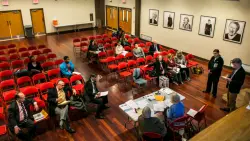Violent extremists like the Minnesota shooter are not lone wolves
After a two-day manhunt Minnesota personnel arrested and charged -year-old Vance Boelter on June after he allegedly shot and killed Minnesota House Democratic leader Melissa Hortman and her husband in their home and seriously injured another state senator and his wife Boelter disguised as a police officer went to other Minnesota politicians homes late in the evening on June In his parked car he left behind a list of names and addresses of other Minnesota state and federal elected administrators as well as area leaders and Planned Parenthood locations This case is the latest to demonstrate how political and often hate-based violence is becoming a more common part of American politics Related Attack in Minnesota comes amid rising threats against society functionaries Let me be absolutely clear this was an act of targeted political violence and it was an attack on everything we stand for as a democracy U S Sen Amy Klobuchar of Minnesota noted in a June comment The threat of domestic violence and terrorism is high in the United States especially the danger posed by white power extremists multiple of whom believe white people are being replaced by people of color I am a scholar of political violence and extremism and wrote about these beliefs in a book It Can Happen Here White Power and the Rising Threat of Genocide in the US I think it s pivotal to understand the lessons that can be learned from events such as the contemporary Minnesota shootings After decades of research on numerous attacks that have left scores dead we have learned that extremists are almost perpetually part of a pack not lone wolves But the myth of the lone wolf shooter remains tenacious reappearing in media coverage after almost every mass shooting or act of far-right extremist violence Because this myth misdirects people from the actual causes of extremist violence it impedes society s ability to prevent attacks The lone wolf extremist myth is dangerous FBI Director Christopher Wray stated in August that the nation s top threat comes from far-right extremist lone actors who he explained work alone instead of as part of a large group Vance Boelter is seen in his booking photo on June in Green Isle Minn Hennepin County Sheriff s Office via Getty Images Wray is wrong and the myth of the lone wolf extremist the mistaken idea that violent extremists largely act alone continues to directly inform research law enforcement and the popular imagination I think that Wray s focus on extremism is much needed and long overdue However his line of thinking is dangerous and misleading By focusing on individuals or small groups it overlooks broader networks and long-term dangers and so can impede efforts to combat far-right extremist violence which Wray has singled out as the country s largest part lethal domestic threat Not a new trend Far-right extremists may physically carry out an attack alone or as part of a small group of people but they are almost reliably networked and identify with larger groups and causes This was true long before the social media age Take Timothy McVeigh He is often depicted as the archetypal lone wolf madman who blew up the Oklahoma City Federal Building in In fact McVeigh was part of a pack He had accomplices and was connected across the far-right extremist landscape The same is true of Payton Gendron who shot and killed Black people at a Buffalo New York grocery store in and Patrick Crusius who killed people in a racist attack targeting Latino shoppers at a Walmart in Texas in These two shooters were also characterized in media coverage as lone wolves following their deadly attacks He talked about how he didn t like school because he didn t have friends He would say he was lonely a classmate of Gendron reported shortly after Gendron carried out the mass shooting Both were proceeding on far-right extremist social media platforms and posted manifestos before their attacks Gendron s manifesto discusses how he was radicalized on the dark web and inspired to attack after watching videos of Brenton Tarrant s massacre of people at two mosques in Christchurch New Zealand Almost a quarter of Gendron s manifesto is directly taken from Tarrant s which was titled The Great Replacement This fear of white replacement centered around perceived white demographic decline was also a motive for Crusius His manifesto pays homage to Tarrant before explaining his attack was a response to the Hispanic invasion of Texas The lone wolf myth also suggests that extremists are abnormal deviants with anti-social personalities After Gendron s rampage for example New York Attorney General Letitia James called him a sick demented individual Crusius in turn was described by the White House and news articles as evil psychotic and an anti-social loner The vast majority of far-right extremists are in fact otherwise ordinary men and women They live in rural areas suburbs and cities They are students and working professionals And they believe their extremist cause is justified This point was illustrated by the spectrum of participants in the Jan Capitol insurrection Boelter is a father of five who has worked various jobs in the food industry and with funeral facility companies and a protection provision While Boelter s exact motivation and political affiliation are not clear friends describe him as very religious and conservative Boelter reportedly communicated a roommate and friend that he strongly opposes abortion He has also criticized gay and transgender people during sermons he delivered at a church in the Democratic Republic of Congo Tracing the lone wolf mythology How did the lone-wolf metaphor come to misinform the general s view of extremists and why is it so tenacious Part of the answer is linked to white supremacist Louis Beam who wrote the essay Leaderless Resistance in In it he called for far-right extremists to act individually or in small groups that couldn t be traced up a chain of command According to his lawyer McVeigh was one of those influenced by Beam s call After Beam formulated this idea both far-right extremists and law enforcement increasingly used the lone wolf term In the FBI even mounted an Operation Lone Wolf to investigate a West Coast white supremacist cell The terrorist attacks further turned U S attention to Islamic militant lone wolves A decade later the term became mainstream And so it was not a surprise when after the Buffalo shooting New York State Senator James Sanders disclosed Although this is allegedly a lone-wolf matter this is not the first mass shooting we have seen and sadly it will not be the last The tenacity of the lone wolf myth has several sources It s convenient evocative and powerful enough to draw and keep people s attention By using this term which individualizes extremism law enforcement officers may also depoliticize their work Instead of focusing on movements like white nationalism that have sympathizers in the various levels of regime from sheriffs to senators they focus on individuals The lone wolf extremist myth diverts from what should be the focus of deterrence efforts understanding how far-right extremists architecture organize and as the Jan insurrection revealed build coalitions across diverse groups especially through the use of social media Such understanding provides a basis for evolving long-term strategies to prevent extremists like Boelter from carrying out more violent attacks This is an updated version of an article originally published on Feb Alex Hinton is a distinguished professor of anthropology and director of the Center for the Assessment of Genocide and Human Rights at Rutgers University Newark This article is republished from The Conversation under a Creative Commons license Read the original article The post Violent extremists like the Minnesota shooter are not lone wolves appeared first on MinnPost


